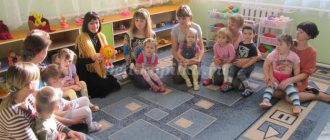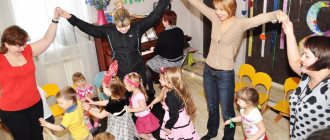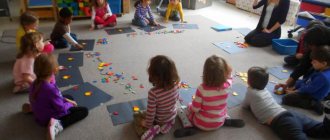Perspective plan of the “Plasticine Miracle” mug
Author: Bobretsova Valentina Stanislavovna
Explanatory note.
Preschool age is characterized by increasing cognitive activity, interest in the world around us, the desire to observe, compare, and the ability of children to realize the goals set for them.
The basis of each lesson is visual activity using non-traditional artistic techniques of fine art - plasticineography.
The principle of this technique is to create a stucco painting depicting more or less convex, semi-volume objects on a horizontal surface. Children are also introduced to the use of a variety of techniques: making decorative moldings of various shapes, pinching, flattening, pulling parts away from the general shape, tightly connecting parts by smearing one part to another.
Each lesson contains not only practical tasks, but also educational tasks, which in general allows for the comprehensive development of the child’s personality. Children gain knowledge, abilities, and skills: the information received in classes on speech development, ecology, and drawing is also consolidated; they are introduced to the world of different objects in the process of partial use of the so-called waste material; the possibilities of children’s visual activities are expanded.
Goals:
· development of individual creative abilities and interest in art in general in the process of plasticineography classes.
· formation and development of children’s artistic and creative abilities through visual activities, creation of the necessary conditions for self-determination and self-realization of the child’s personality.
Tasks:
Educational:
· To form a sustainable interest in artistic modeling.
· Teach special technologies for working with plasticine, consolidate acquired skills and abilities, and show the breadth of their possible application.
· Provide theoretical knowledge and develop students’ practical techniques and skills in working with plasticine.
Educational:
· Contribute to the development of cognitive activity, the development of creative thinking, imagination, fantasy.
· Contribute to the development of spatial awareness and color perception.
· Develop artistic taste, imagination, ingenuity.
· Develop fine motor skills of the fingers.
Educators:
· To promote students’ interest in artistic and creative activities, the desire to master knowledge and skills in working with plasticine.
· Cultivate hard work and accuracy.
· Cultivate aesthetic taste, love for beauty.
· To instill in children an interest in each other’s visual activities, a friendly attitude and mutual assistance, and to develop cooperation skills.
Materials:
— sets of plasticine;
- stacks, boards, wet wipes;
— sets of thick cardboard of different shapes, colors, disposable tableware, different in shape and size;
— photos or illustrations depicting various compositions and objects;
- various waste materials (beads, seed beads, toothpick, etc.).
Plasticineography classes are held once a week, on Tuesday. The duration of the lesson is 20 minutes.
Sample table of activities.
October.
| A week | Lesson topic | Tasks |
| 1,2. | "Balloons" | 1. Strengthen the ability to roll out lumps of plasticine using circular movements. 2. Teach how to transform a spherical shape into an oval shape with straight movements of the palms. 3. Teach how to attach the finished form to a plane by uniformly flattening it over the surface of the base. 4. Develop aesthetic and figurative perception. |
| 3, 4. | “The apples are ripe in the garden” | 1. To develop children’s aesthetic perception of nature and teach them to convey the image of a fruit tree through plasticineography. 2. Teach children to pinch off small pieces of plasticine and roll small balls using circular movements of their fingers. 3. Strengthen the ability to flatten balls over the entire surface of the silhouette (tree crown). 4. Develop imaginative perception. |
November.
| A week | Lesson topic | Tasks |
| 1,2. | "Starry Sky" | 1. Teach children to convey the image of the starry sky through plasticineography. 2. Strengthen the skills of working with plasticine: rolling out lumps with straight movements, bending into an arc, flattening the ends of an object. 3. Teach children to divide the finished shape into small parts using a stack and roll them into balls in a circular motion on a plane, stimulating the active work of their fingers. 4. Develop compositional and spatial perception. |
| 3,4. | "Beads for Lucy" | 1. Strengthen children's ability to sculpt an object. Consisting of several parts, place the elements (beads) close to each other, in a certain order. Alternating by color. 2. Improve the ability to roll a sausage out of plasticine with straight movements, divide it into equal parts using stacks. 3. To clarify children's knowledge about the round shape of objects, to consolidate the ability to sculpt small balls by rolling them with a circular movement of the fingers. 4. Consolidate knowledge about color, develop a sense of rhythm. |
December.
| A week | Lesson topic | Tasks |
| 1,2. | “The sun woke up and smiled at the children” | 1. To cultivate in children responsiveness, kindness, the ability to sympathize with characters, and the desire to help them. 2. Learn to convey the image of the sun, improving children’s ability to roll a piece of plasticine between their palms, giving it a spherical shape. Teach the technique of flattening a ball on a horizontal surface to obtain a flat image of the original shape. 3. Practice rolling out lumps of plasticine with straight movements of both hands. 4. To support in children the desire to complete what they have started, following the playful motivation of the activity. |
| 3,4. | "We shared an orange" | 1. Continue to teach children to convey the shape, structure, and characteristic parts of famous fruits in their work. 2. Strengthen the ability to roll plasticine between the palms with straight and round movements, and pull out the necessary parts of objects with your fingers. 3. Learn to use additional objects in your work to convey the characteristic features of objects. 4. Develop skills in careful handling of plasticine. |
January.
| A week | Lesson topic | Tasks |
| 3,4 | "Turtle" | 1. Arouse interest in representatives of the animal world, talk about the features of the turtle’s appearance and lifestyle. 2. Strengthen the skills and abilities of working with plasticine: rolling out parts of an object in a circular motion, connecting individual parts into a single whole, flattening, applying a relief pattern using stacks. 3. Learn to depict an object, conveying the resemblance to a real object. 4. Cultivate a caring attitude towards living beings. |
February.
| A week | Lesson topic | Tasks |
| 1,2. | "Balls for a kitten" | 1. Continue to develop an interest in new sculpting methods. 2. Practice rolling plasticine between your palms with straight movements, rolling it with the fingers of both hands on the table surface to give the object the required length. 3. Teach children how to roll a long sausage in a spiral. 4. Develop fine motor skills of the hands. |
| 3,4. | "Snail, snail, let out your horns" | 1. Continue to develop children’s interest in depicting objects with plasticine on a plane. 2. Exercise children in rolling pieces of plasticine between their palms with straight movements of both hands. 3. Learn to sculpt a snail by rolling the sausage in a spiral. 4. Supplement the object with the necessary details to express the image (horns, tail), using familiar sculpting objects: pulling, flattening, making cuts in a stack. |
March.
| A week | Lesson topic | Tasks |
| 1,2. | "The plane is flying" | 1. Strengthen the ability of children to divide a block of plasticine into two equal parts by eye, and roll it out with straight movements of the palms. 2. Teach children to compose an object consisting of several parts on a plane, to achieve an accurate representation of the object’s shape, its structure, and parts. 3. Supplement the image with characteristic details (porthole windows), using familiar sculpting techniques: rolling, flattening. 4. Continue to develop children's interest in working with plasticine on a horizontal plane - plasticineography. |
| 3,4. | “The hen went out for a walk, and the chickens followed her.” | 1. Teach children to create an image of a whole object from parts that are the same in shape but different in size. 2. Strengthen the techniques of rolling plasticine between your palms in circular and straight movements. 3. Strengthen children's ability to evenly flatten ready-made shapes on a base to obtain a flat image, changing the position of body parts (a chicken walks, a chicken pecks). 4. Learn to compose a composition from several objects, freely arranging them on a sheet of paper. |
April.
| A week | Lesson topic | Tasks |
| 1,2. | "The Little Mouse and the Golden Egg" | 1. Learn to depict fairy-tale characters using plasticine. 2. Teach how to transform a spherical shape into an oval shape with straight hand movements. 3. Strengthen the ability to convey the character of a form using familiar sculpting methods: rolling, pulling parts of an object, flattening. 4. Develop the plot and game concept. |
| 3,4. | "Duck with Ducklings" | 1. Learn to analyze the structure of an object, the shape and size of its individual parts. 2. Strengthen the ability to transform a spherical shape into an oval one. 3. Continue to master some operations: bend the finished shape into an arc, pull off the parts and come up with the desired shape for them (duckling tail). 4. Develop a sense of form and composition. |
May.
| A week | Lesson topic | Tasks |
| 1,2. | "Rainbow-arc" | 1. Exercise children in rolling out sausages of different colors of approximately the same thickness and different lengths using straight movements of both hands. 2. Teach children to depict the arc-shaped shape of the rainbow and the order of the colors in it. 3. Continue to teach how to use a stack to cut off excess ends when laying down rainbow stripes. 4. Develop a sense of beauty (a beautiful multi-colored rainbow). |
| 3,4. | "Butterflies" | 1. To expand children's knowledge and understanding of the features of the appearance of a butterfly. 2. Introduce symmetry using the example of a butterfly in nature and in drawing. 3. To improve children’s ability to work in non-traditional visual techniques - drawing with plasticine, to expand knowledge about the capabilities of this material. 4. Teach children to apply strokes with plasticine, smoothly “pouring” one color into another at the border of their connection. |
To draw up a long-term plan, the manuals of G.N. Davydova were used.
"Plasticineography". comments powered by HyperComments




